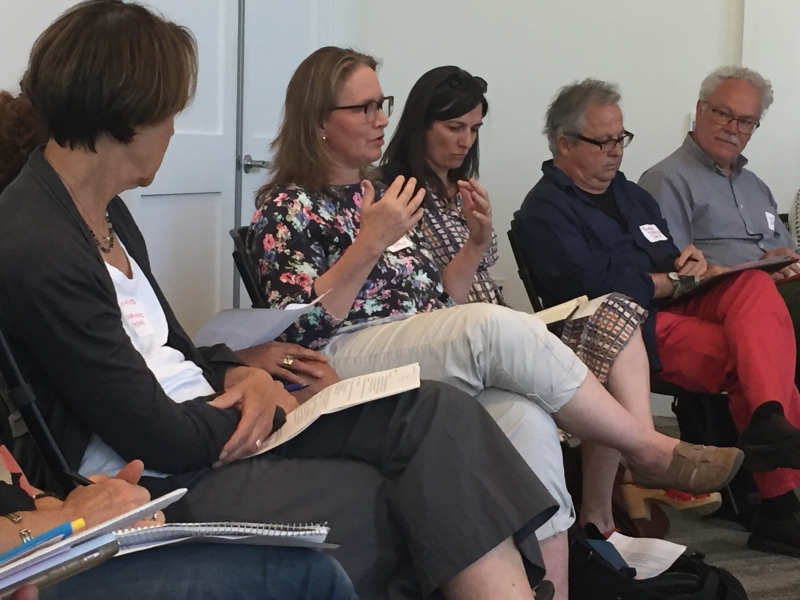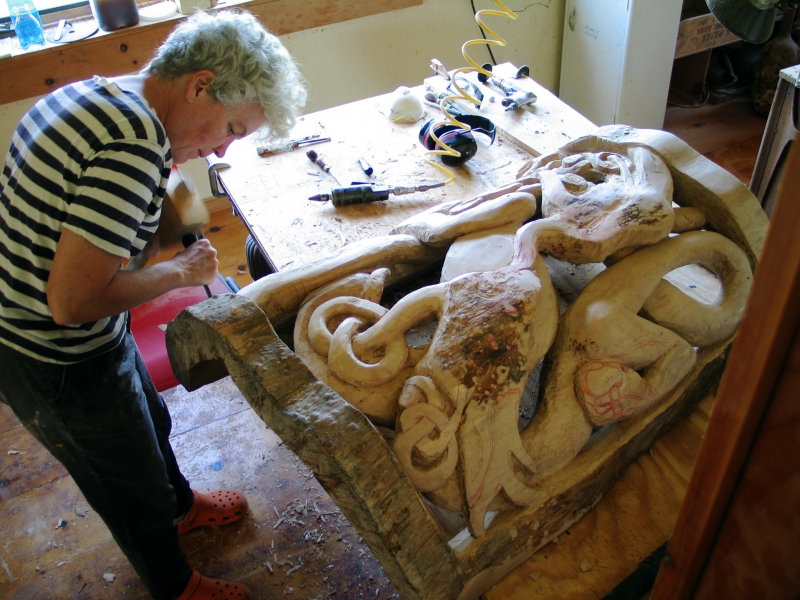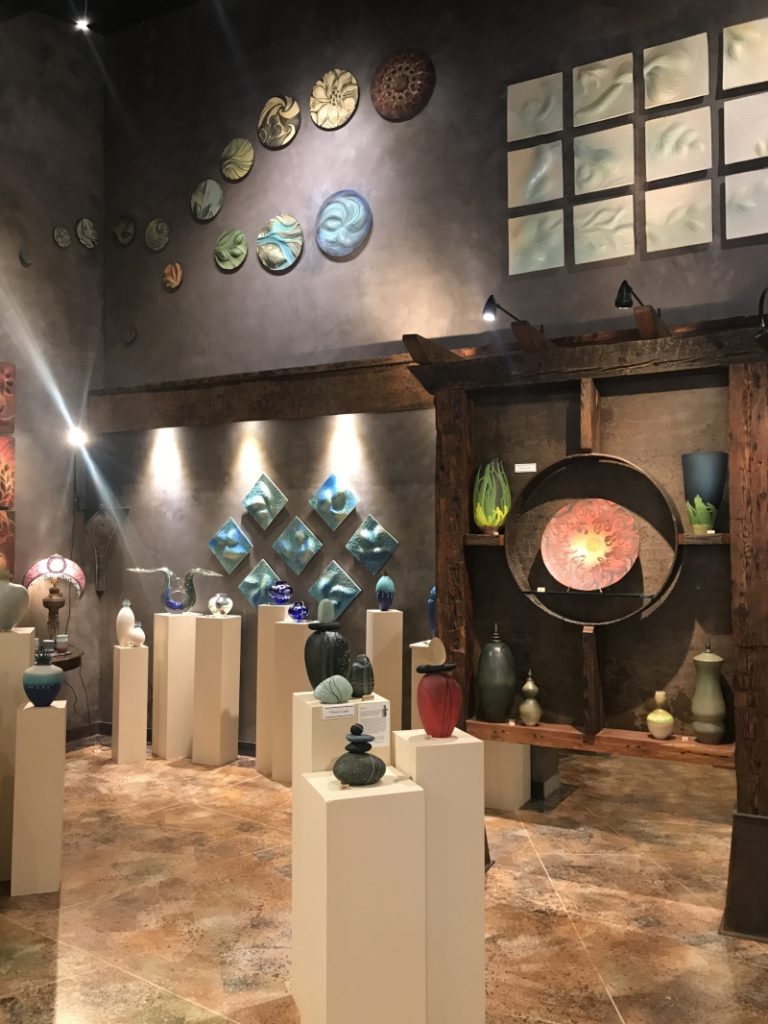
At a gathering of arts organizations located in Southern Vermont for one of the Southern Vermont Comprehensive Economic Development Strategy (CEDS) Arts Focus group meetings facilitated by representative Laura Sibilia, high-level ideas were captured as part of the focus group and were fed into the CEDS. Dina Janis, the artistic director of the Dorset Theatre Festival, speaks with other arts leaders.
The Green Mountain State is sitting on a gold mine
As reported in Artsy Magazine in 2018, the arts and cultural sector contributed “over $763.6 billion to the American economy in 2015 — more than the agriculture, transportation, or warehousing sectors, according to new U.S. government data released in 2018 by the Bureau of Economic Analysis (BEA) and the National Endowment for the Arts (NEA).
“The arts generated 4.2% of the overall U.S. GDP, with roughly 4.9 million Americans working in the sector in 2015, the latest year for which data is available. Collectively, those employed in the sector earned over $370 billion, according to the findings.
“The sector expanded by an average of 2.6% annually between 2012 and 2015, just outpacing the 2.4% growth of the economy overall, according to the report. Between 2014 and 2015, the sector grew at a rate of 4.9% after adjusting for inflation.
“‘The data confirm that the arts play a meaningful role in our daily lives, including through the jobs we have, the products we purchase, and the experiences we share,’ said NEA chairman Jane Chu in a statement.”
One reason for the study: potential severe cuts to — or even potential elimination of — the NEA.
Here in Vermont, arts organizations are fighting the same fight at the state level. Study after study have proven that the arts make a real difference in all aspects of our lives, including boosting economic development. All show that the arts represent a real industry to take seriously, just like tourism or agriculture.
Why, oh why, can’t arts and culture get a seat at the table?
Two nonprofits in Iowa are spearheading an aggressive effort, “Strengthen Grow Evolve,” to make Iowa City “the greatest small city for the arts in America.”
Here’s what the 75,798 people who live there say about themselves: “Iowa City is a great city for the arts. We are known for our rich culture. It is why people live here, what people remember when they come to visit, and the charm that attracts new people to call this place home.”
In contrast, here in Vermont we are shouting out: “maple syrup, beer, and cheese.”
It seems that promoting arts and culture is on the bottom of the list when it comes to touting Vermont, even as our state can boast the highest numbers of artists per capita.
In a 2018 post, the website Culture Trip (theculturetrip.com) stated that there’s an adage in Vermont that “there are as many galleries as towns.” While the post acknowledges the exaggeration, it’s not an outrageous claim: the Vermont Craft Council’s upcoming Vermont Studio Tour by itself lists 153 studios and galleries participating from a state that is made up of only 255 municipalities.
Culture Trip goes on to say that Vermont’s traditional heritage of farming has shaped its modern appreciation for food, art, and politics, giving it “one of the most unique cultures in all of America.”
Yes — “one of the most unique cultures in all of America.”
Wow! To ignore or downplay the unique culture of Vermont is just nuts. It should be shouted from the highest mountains (of which we have many).
And funded at the highest levels.
There’s a real history as to why we are who we are.
Artists were drawn into our creative orbit in Vermont in the late 1960s and early 1970s for many reasons, including the back-to-the-land movement, the rise of American craft, and the powerful cluster of creative souls migrating to the back woods and small villages of our state.
In the cultural foment of those times, impulses toward self-sufficiency and back-to-the-land fused with rejections of the industrial and the artificial, further feeding the supply of artisans who came to Vermont’s quiet towns and back roads to live and work.
No doubt, Vermont’s agrarian heritage created a culture of the arts, which continue to this day.
But while the end product of the arts — the art itself — has long added depth, beauty, and identity to the Green Mountain State, people are still not used to the arts as an important economic force in our state. The creative spirit generally transcends the profit motive.
If anything, that genuine passion, from people who are moved by something within to create something for us all, makes their work even more valuable and imbues it with heart and professional integrity.
But that also explains why the mean hourly wage for our artists is $16.35 per hour, according to federal statistics. Artists in general aren’t wired like entrepreneurs, industry lobbyists, or corporate professionals, though a gifted few can use multiple skill sets (or have spouses with same) to make their art and make their living. We chronicle that dichotomy in every issue of this magazine.
There’s a huge gap between the Vermont that is — one with a robust presence of the arts — and the Vermont that the state creates, supports, and promotes to lift our fortunes. We hardly need another study to prove once more that the arts deserve a seat at the table.
Note: You can find direct links to the data and the studies referenced here on our website, vermontartsliving.com.
Kudos to Marlboro Wood Carver
Southern Vermont woodturner and wood carver Michelle Holzapfel recently was awarded an unrestricted $50,000 fellowship from the United States Artists (USA) philanthropic organization. She was one of 45 artists and collectives selected. Each year, United States Artists awards up to 50 unrestricted fellowships to the most compelling artists working and living in the U.S., in all disciplines, at every stage of their career.
Spanning creative disciplines including architecture and design, craft, dance, film, media, music, theater and performance, traditional arts, visual art, and writing, USA Fellowships are awarded through a rigorous nomination and panel selection process
Michelle is thrilled. She tells us she supposes that she stands out as a woman woodworker in a male-dominated field.
“You learn to grow thick skin,” she says.
As for what she plans to do with the award, she says she’s looking to do less carving as she gets older—she might write a book. Above all, she’s interested in encouraging and inspiring young people working in craft.
As she told The Commons [commonsnews.org] in 2017, “I have now been doing this work for so many years that I feel like a relic. Everyone has a story to tell but most don’t get the chance to tell it. I am grateful I have been given that opportunity. I want to inspire younger people working in craft and to encourage them to hang in there, just as I did.”
You can visit David and Michelle Holzapfel’s Applewoods Studio at 2802 Route 9 in Marlboro by calling first to make arrangements to visit. It’s worth the trip. The studio will be open during the statewide open studio tour on Memorial Day weekend. David has been making furniture and objects from the unhewn hardwoods of Vermont for four decades. The couple opened Applewoods Studio more than 40 years ago and are going strong. [holzapfelwoodworking.com]
The West River Mile May Just Have it All Neatly Packed Into One Little Mile
THE RETREAT FARM, Fire Arts Vermont, Saxtons River Distillery, and Grafton Village Cheese, all within a mile of each other, offer a terrific way to experience a taste of Southern Vermont.
Here you can imbibe in cheese tastings; sample award-winning maple and coffee liquors; see wonders wrought in artists’ studios; shop artfully for jewelry, glass, ceramic, furniture, and sculpture; visit working farms; shower the kids with amazing activities; hike the trails; and grab a quick meal from a yummy food truck.
Your first stop might be Fire Arts Vermont, the gorgeous showroom and live open working studios of award-wining fine craft artisans Randi Solin (one of a kind art-glass) and Natalie Blake (ceramic tile, vessels and functional pottery). They are a multifaceted destination where you can watch, close up, as molten glass becomes artwork: Feel the heat from the furnace and learn about the ancient techniques of blown glass.
Then cool down at Natalie Blake’s ceramics studio and view the custom projects in progress for small residential and large-scale public installations across the country. There are learning opportunities to sign up for classes, or commission a custom piece of art for your home—or as a special gift.
Saxton’s River Distillery is in the same building where you must taste the maple and coffee liquors. Then move on to the Retreat Farm and Grafton Village Cheese. Find them both on the same property. Indulge your palate with award winning cheeses and work it off at the Retreat Farm, visiting the animals and hiking a trail. There’s even a trail just for kids.
The West River Mile destination is a true Vermont experience not to be missed. The four companies together make the West River Mile a darling of the tourism community.























































